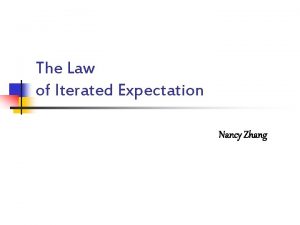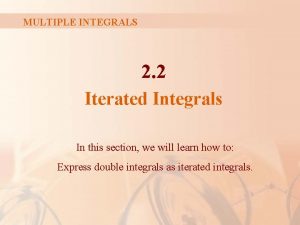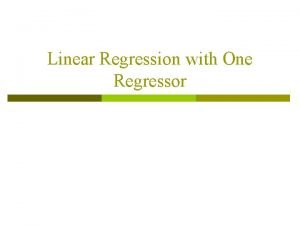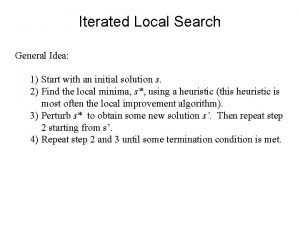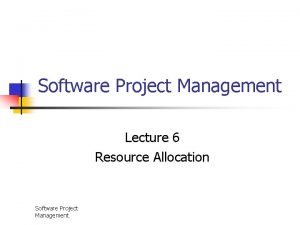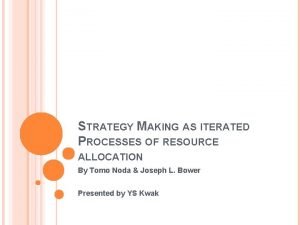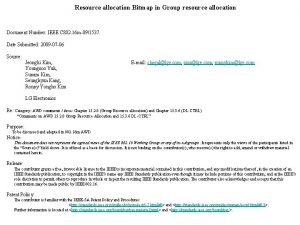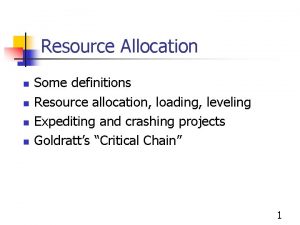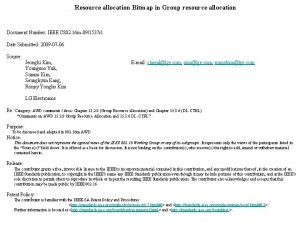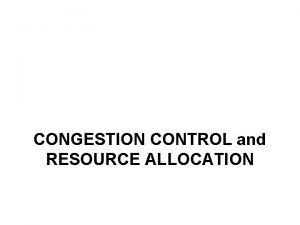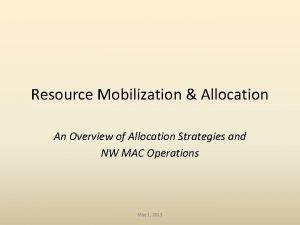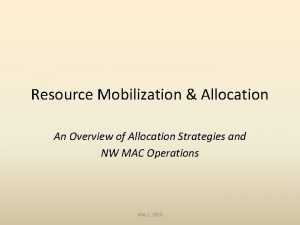STRATEGY MAKING AS ITERATED PROCESSES OF RESOURCE ALLOCATION














- Slides: 14

STRATEGY MAKING AS ITERATED PROCESSES OF RESOURCE ALLOCATION By Tomo Noda & Joseph L. Bower Presented by YS Kwak

CONTENTS Introduction B-B Process Model Bell South & U S WEST Conclusion- Propositions I, III Contribution Critique

INTRODUCTION Discussion of strategy: � Chandler, 1962 & Andrews, 1971 � Ansoff, 1965 & Porter, 1980 � Allison, 1971 � Barnard, 1938 & Simon, 1945 & Cyert and March, 1963 & Crozier, 1964 � Schumpeter, 1934 & Nelson and Winter, 1982 & Thompson, 1967 & Pfeffer and Salancik, 1978 & Miles, 1982 � Mintzberg and Mc. Hugh, 1985 � Lindbloom, 1959

B-B PROCESS MODEL Bower-Burgelman process model of strategy making: � 3 organizational levels & 4 subprocesses Levels: bottom, middle, and top managers Subprocesses: Definition and Impetus (interlocking bottom-up core processes) & Structural and Strategic context determination (overlaying corporate processes) Goal: -To explore critical gap and extend B-B model, then describe the research design and field study based on extended version of B-B model to explain propositions -Using TWO firms (1983 – 1994)

BELL SOUTH & U S WEST Similarities: � 1. Start point- same age � 2. Technology � 3. Market- great deal of uncertainty Result: largest vs. smallest

BELL SOUTH & U S WEST Different strategies 1 st period (1983 – 1985) � Different business strategies taken by business unit officers � Different management style: Traditional centralized vs. Decentralized – different business development practices � Different structural context in financial grip on business units � Different strategic contexts � Different business plans for business units � Different operating results in relatively similar local markets

BELL SOUTH & U S WEST 2 nd period (1986 – 1989) � Strategic forcing by business-unit officers � Strategic building by middle managers � Confidence building by top corporate executives � Influence of corporate contexts on the impetus process

BELL SOUTH & U S WEST 3 rd period (1989 – 1994) � More vs. Less investment to wireless communications businesses � Different cellular operations by middle managers � Different top manager’s conductions

CONCLUSION- PROPOSITIONS I Top managers exercise a critical influence on the strategic initiatives of lower-level managers by setting up the context in which these managers make decisions and take actions Both strategic and structural contexts influence bottomup initiatives in the definition process, and shape resource allocation in the impetus process in a way what virtually defines a course of business development and subsequent emergence of a corporate strategy for the new business A firm’s structural context is relatively stable over time, and its persistent impact on the subsequent business development process constrains the discretion of top managers who may want to change the firm’s course of actions in response to the development of technology and the market for a new business

PROPOSITIONS II In the case of a new business development that involves a high degree of uncertainty, the iterations of the resource allocation process generate a pattern of escalation or deescalation of a firm’s strategic commitment based on early results from operations that confirm or disconfirm the premises of the first investment and the credibility of the champions

PROPOSITIONS III In the case of successful business development, continuous, incremental learning of top managers during business development, and the resulting fine turning of strategic context, shift resource allocation and precede the articulation or change in official statements of the corporate strategy for the new business

CONTRIBUTION Shows that role of middle managers is significant factor for success Comparative longitudinal study May help strategy researchers in the iterative approach and formal strategy making process

CRITIQUE Why are Bell South and U S WEST different so far? Is it able to achieve same success when we use same strategies that Bell South had been conducted? If it is not, then why? Is it the best strategies only in high uncertain market condition?

THANK YOU
 Resource leveling is the approach to even out the peaks of
Resource leveling is the approach to even out the peaks of Contiguous allocation vs linked allocation
Contiguous allocation vs linked allocation Iterated expectation
Iterated expectation Iterated integral
Iterated integral Iterated conditional modes
Iterated conditional modes Law of iterated expectations
Law of iterated expectations Iterated local search
Iterated local search The strategy making strategy executing process
The strategy making strategy executing process Resource requirements example
Resource requirements example Algoritmo banchiere
Algoritmo banchiere Resource aggregation
Resource aggregation Resource allocation graph and wait for graph
Resource allocation graph and wait for graph Resource allocation graph
Resource allocation graph Resource allocation graph with a deadlock
Resource allocation graph with a deadlock Deadlocks
Deadlocks


